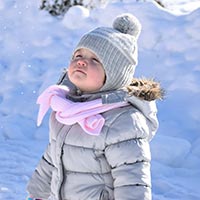Hypothermia and Frostbite

With the winter months here and the cold weather inevitable, it's time to think about the effects of freezing cold temperatures on our bodies. Hypothermia (low body temperature) occurs when heat escapes from your body faster than the body can warm itself. When you're out in the cold, the body tries to maintain its core temperature to protect vital organs. In order to do so, the body shifts blood away from the extremities (hands, feet, nose, and ears) and directs it toward the core organs (heart and lungs). This increases the risk of local cold injury such as frostbite to those extremities. Body tissues can actually freeze when they are exposed to extended extreme cold conditions causing physical injury and permanent changes in the skin. It takes only minutes for exposed skin to become frostbitten if the temperature is below 20 degrees F and wind chill values of 18 below zero or lower.
Causes of Hypothermia
In addition to being exposed to extreme cold and damp conditions, common causes of hypothermia include:
- Being outside without enough protective clothing
- Being in cold water for an extended time
- Wearing wet clothing in cold weather
- Alcohol consumption
- Heavy exertion
- Poor heating conditions
- Poor nutrition
According to the Centers for Disease Control and Prevention, body temperature that is too low affects the brain, making a person unable to think clearly or move well. The elderly and children are particularly susceptible to frostbite. Other victims may include people who remain outdoors for long periods of time such as hikers, hunters and the homeless.
Signs and Symptoms
Hypothermia can be fatal, so it's important to know the signs and symptoms.
In adults:
- Shivering
- Exhaustion
- Confusion/memory loss
- Pale and cold skin
- Slurred speech
- Numbness or tingling
In children:
- Bright red, or white, pale cold skin
- Low energy levels
- Pain in areas of frostbite
Treatment
It is easier to prevent frostbite than to treat frostbite. Hypothermia is a medical emergency and frostbite should be evaluated by a healthcare provider. Dial 911 immediately if needed and stay with the person until medical help arrives should they become confused or have changes in mental status. If symptoms are present, get the person to a warm place and cover with a warm blanket. Cover the person's head and neck to help retain body heat. If the clothing is wet, change into dry clothes. Unless absolutely necessary, do not walk on frostbitten feet and toes or rub the areas as this could cause more tissue damage. It is not recommended to use a heating pad, heat lamp, or the fire of a stove, fireplace, or radiator for warming.
Prevention
Proper clothing is essential to protect the body in cold weather conditions including mittens, socks, scarf and a hat. Dress in layers with synthetic and woolen fabrics instead of cotton. Before spending a lot of time in extremely cold weather, do not drink alcohol or smoke. Do, however, drink plenty of fluids and get an adequate intake of food and rest. Infants lose body heat more easily than adults, so it is essential to keep them covered with blankets and at a warm indoor temperature. Physical activity will also raise body temperature to keep the body warm. It is a good idea to take a first aid and CPR course to prepare for cold weather health problems. Knowing what to do will protect your health as well as the health of others.
For further information, visit websites:
www.nlm.nih.gov/medlineplus/frostbite.html 
https://www.cdc.gov/disasters/winter/ 
http://www.mayoclinic.org/symptoms/cold-hands/basics/definition/sym-20050648 

